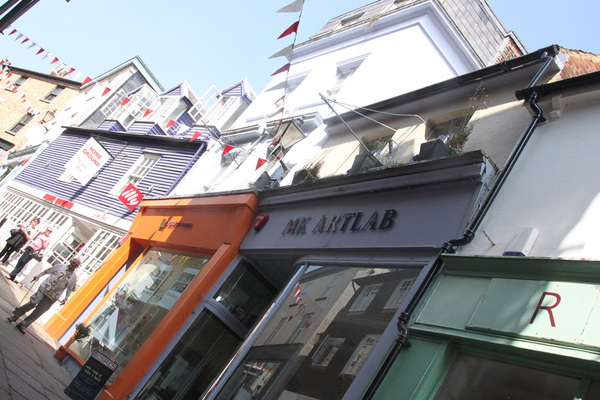Candidate: Creative Quarter
Location: Folkestone, UK
Category: The Great Neighbourhood Award
Year: 2013
Learning Moments
1. Neighbourhood versus visitor attraction
There are many approaches to culture-led regeneration and many assumptions about its potential. A longer term study of Folkestone will determine whether a philanthropic intervention like the De Haan Trust’s can create a true ‘neighbourhood’, in the sense of it being a relatively self-contained social and economic community with identifiable social networks, with the potential to revitalise a once vibrant town. The Cultural Quarter must be more than a visitor attraction to develop into a living, sustainable community, and this is likely to happen once the surrounding harbour area is developed and the impact of the area filters into the rest of the town.
2. A unique business / landlord model
It will be a very interesting to evaluate the impact of the Trust and the Creative Foundation acting as a philanthropic super landlord with an ambitious and holistic vision, providing a high level of service, cheap and peppercorn rents and able to act as a catalyst/negotiator/visionary promoting the wider Renaissance of Folkestone in a challenging economic climate. Generally such initiatives rely on public sector energy or funds and cannot have the long term commitment that the de Haan Trust is able and willing to give.
3. A charitable model
A significant advantage of this approach is that the Trust and the Creative Foundation can make its own choices, implement its ideas more rapidly and develop a wider range of partnerships than those led by public sector agencies. Within the Creative Quarter there is strong evidence of commercial development, meeting community needs, solving urban and social blight and working alongside adult and higher education sectors. It is unlikely that this could have happened at the same pace through public investment and decision making alone.
Assessment Summary
The Creative Quarter is an ambitious, culture-led project focussed on the regeneration of the historic core of Folkestone Old Town and part of Roger de Haan Charitable Trust’s commitment to the regeneration of his home town, which suffered a huge economic blow when the ferry terminal closed and the links to the Channel Tunnel bypassed it.
At its heart lies an intervention funded by the Trust to purchase and refurbish a number of run-down properties and pass them on to the Creative Foundation on 125 year peppercorn leases so that they can then be let at affordable rents to artists, craft workers and other small businesses, including cafes and restaurants. The Trust is committed to delivering both environmental and socio-economic regeneration and has funded significant education and community initiatives to bring young people and adult learning into the Quarter.
Whilst it may not yet be an established ‘neighbourhood’ and it is very much work-in-progress, it is an ambitious attempt to use 21st century philanthropy to stimulate inclusive and ‘bottom-up’ regeneration based around small businesses and individual imagination and skill.
The Creative Quarter also needs to be viewed in the context of the Trust’s wider plans for the town as a whole. These include the improvement of the port area, where the newly created Rocksalt restaurant is already attracting new visitors to the town, as well as the Trusts’ acquisition of , and plans for, developing the former harbour and adjacent foreshore to create a substantial housing and commercial development.
This is regeneration led by philanthropic motives and not the public sector and, although it does not figure significantly in Shepway Council’s Town Centre strategy, after a shaky start the Council now fully supports the initiative and recognises its wider benefits for the whole of Folkestone.
To ensure that all stakeholders are involved in developing and delivering the wider vision and in addition to its day-to-day engagement with the cultural and commercial community, the Creative Foundation organises quarterly meetings with local authorities and business representatives to discuss the planning, design and management of the Creative Quarter.
It is interesting to compare the Folkestone initiative with more dramatic architectural interventions in similar seaside towns such as the Jerwood Foundation at Hastings and the Turner Contemporary at Margate or the art led approach in Skegness. In several ways it is already evident that the Folkestone initiative has the potential to be more sustainable in the long term because of its emphasis on nurturing creative people and small businesses, rather than relying on iconic architecture and art galleries. As well as its business led developments the Creative Foundation also supports the Folkestone Triennial, an international sculpture exhibition attracting leading artists and leaving a legacy of high quality public art around the town.
The Creative Quarter has a strong and distinctive character which derives from its steep seaside topography and the remarkably intact, and now well restored, range of buildings from the 18th to 20th centuries which line the streets within the Old Town Conservation Area. The growth in arts-related businesses, cafes and the nationally recognised Rocksalt restaurant has added significantly to the culture and identity of the place and there is evidence that the impact of the Quarter is already extending beyond its boundaries.
Whilst some assessors felt that as a ‘cultural quarter’ the Folkestone site lacks the spontaneity and edge that can be seen in areas where self administered artist studios or creative industries have driven the desire for change (such as the Lacemarket area of Nottingham 20 years ago), it is, nevertheless, a bold initiative and it would be very instructive to compare and contrast the approach to culture-led regeneration in Folkestone with other urban cultural quarters and to assess the different criteria for success. The Cultural Quarter is now a major visitor attraction and it will be interesting to study over time how its impact ripples out into the surrounding areas in the Town Centre and contributes further to the creation of a living and sustainable community.









